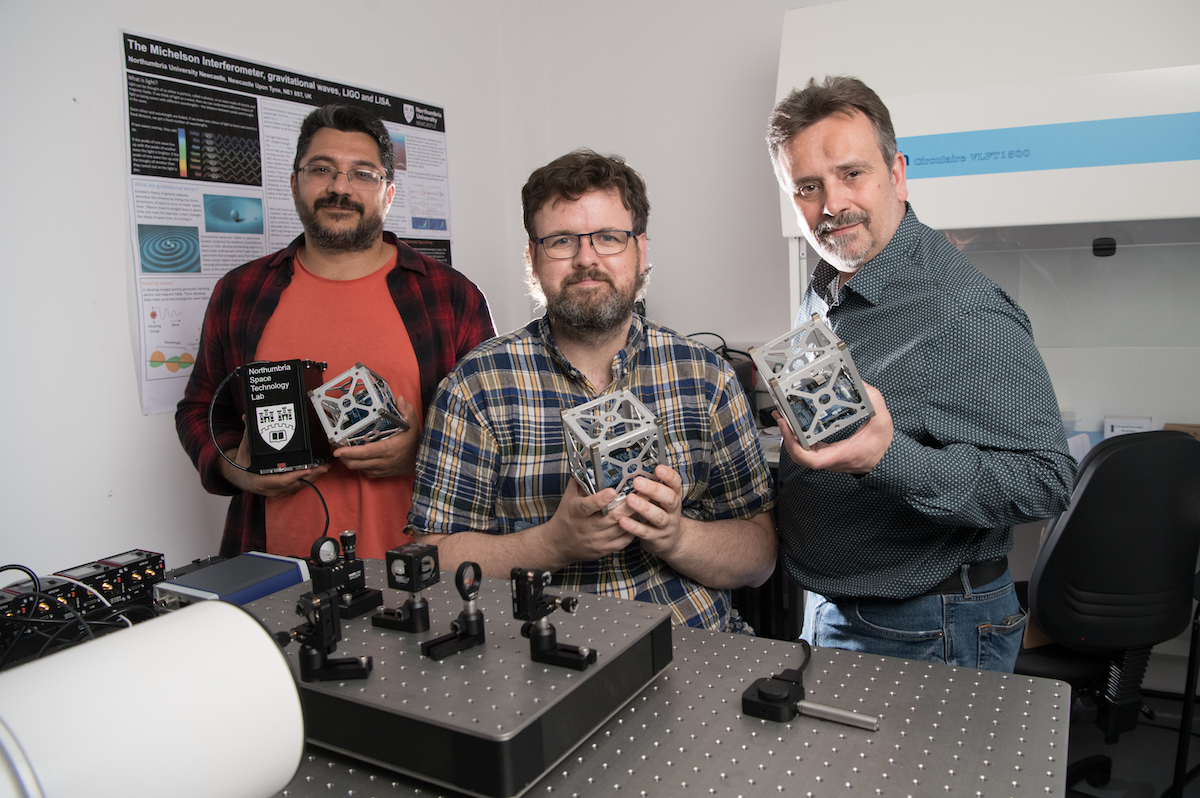Members Login

Channels
Special Offers & Promotions
Northumbria University preparing for satellite launch after £5m boost for satellite communications research

A £5 million award from the UK Space Agency will allow Northumbria University to take forward world-leading research to build a new satellite communications system, setting the scene for Northumbria to launch the UK’s first university-led multi-satellite space mission.
The funding announcement made today allow the University to move forward with its prototype work on this new laser-based system, which has the potential to transform the satellite communications industry.
Researchers from Northumbria’s Solar and Space Physics research group have been leading a consortium whose goal is to develop the world’s first commercially available system that allows satellites to communicate with each other via lasers rather than radio frequencies.
Satellites currently use radio frequencies to transmit data, but this has limited capacity and is more vulnerable to disruption. However, lasers can transmit 1,000 times more data per second than radio frequency and can transmit much more securely.
Northumbria’s laser-based device could potentially become the predominant communications mechanism for satellites in future.
The UK Space Agency had already awarded over £1 million to Northumbria to fund the earlier phases of this inter-satellite communications research through its National Space Innovation Programme.
It was one of 22 projects initially chosen to receive funding in 2020, with further funding granted in 2021 after showing highly promising potential. It is now one of only two projects selected for this third and final phase of funding.
The UK Space Agency’s £4.98 million award will allow the consortium to design, test and build the first CubeSat with laser optical communications technology.
It is expected to launch in 2025.
Through the University’s Northumbria Space Technology Laboratory, experts have been working in partnership with Durham University, satellite communications specialists e2E, and manufacturing company SMS Electronics Limited to create this new system.
The consortium recently expanded to include global aerospace company Lockheed Martin, which joined forces with Northumbria University last year. Lockheed Martin will be leading the system’s engineering development.
Professor Eamon Scullion, a solar physicist at Northumbria University is leading the project. He said: “We are absolutely thrilled to be one of the two final projects chosen by the UK Space Agency for funding after a highly competitive process over the last three years.
“With our new technology, we are not only bridging the gap between satellites in low Earth orbit but we are bridging an even bigger gap between academic R&D and industry.
“Thanks to previous funding from the UK Space Agency we have established the working principles and a prototype of a unique, compact, lightweight, high-speed inter-satellite laser optical communication device.
Professor Robert Wicks, Head of Northumbria Space Technology Laboratory at Northumbria University, and CubeSat development lead on the project, added: “We are now ready to follow a rigorous technology-readiness process to build and test of a pair of flight-ready, payload-integrated CubeSats that are not only ready for launch to space in 2025 but will also be ready for sale as the UK’s first commercially available laser communication device for small satellites.
“We are very excited to be designing, building and testing our very own CubeSat mission here in the Northumbria Space Technology Laboratory. It is a great way to get our Electronic Engineering and Physics students involved in cutting-edge research.”
Tony Forsyth, Head of Space Technology at the UK Space Agency, said: “This funding will support Northumbria University to develop its innovative technology that will enhance inter-satellite communications systems by using efficient optical lasers, in comparison to the traditional devices.
“The UK Space Agency’s National Space Innovation Programme prioritises funding for innovative technologies that will enhance UK space capabilities and help the sector, already worth £16.5 billion to the UK economy, continue to grow.”
Professor Andy Long, Vice-Chancellor and Chief Executive of Northumbria University, said: “This important announcement from the UK Space Agency recognises the real excellence around space research at Northumbria and reinforces the aims of the University and the wider North East region to be a leader in the global space economy.
“This is a hugely exciting prospect which puts world-leading research into transformative technologies from Northumbria University one step closer to going into orbit.”
Nik Smith, Lockheed Martin’s Regional Director for UK and Europe, said “Lockheed Martin is thrilled to join this Laser Comms programme with Northumbria University and its partners to support the satellite communications system’s development.
“Northumbria has some of the best and brightest talent for space and will be instrumental to the future of UK’s space sector. As we plan for that future, we believe there is significant export market potential for this kind of technology.”
Dr Cyril Bourgenot from Durham University’s Centre for Advanced Instrumentation (CfAI) is principal co-investigator on the project. He said that the Durham University team was delighted to be involved in the development of this Free Space Optical Communication demonstrator.
“This technology will have such a strong societal impact and is a huge opportunity for the North East to showcase its space-borne instrumentation capabilities,” he added.
Northumbria University’s Solar and Space researchers work to understand the physics of the Sun and all aspects of the solar-terrestrial connection. Their research will improve space weather forecasting while helping to develop and deploy new instruments, models and services.
The group demonstrates international leadership across theory, numerical modelling, observations of solar and space plasma, data intensive science, and space-related hardware and collaborates extensively with partners including UK Research and Innovation, the UK Space Agency, the European Space Agency, the UK Met Office and over 40 industrial partners.
Media Partners


